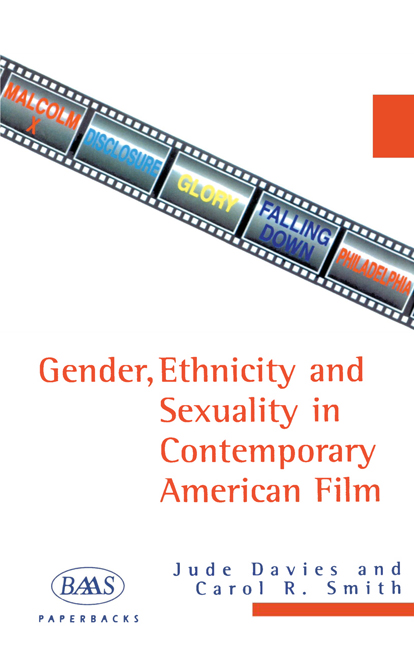Book contents
- Frontmatter
- Contents
- Acknowledgements
- Introduction: The Uses of Identity in Post-Reagan Hollywood Film
- 1 White Masculinity as Paternity: Michael Douglas, Fatherhood and the Uses of the American Family
- 2 Transactions in Race and Ethnicity: Positive, Negative and Interrogative Images of African Americans on Film
- 3 Putting the Homo into America: Reconstructing Gay Identities in the National Frame
- Conclusion: Aliens from Star Wars to Independence Day
- Index
- Miscellaneous Endmatter
2 - Transactions in Race and Ethnicity: Positive, Negative and Interrogative Images of African Americans on Film
Published online by Cambridge University Press: 24 September 2020
- Frontmatter
- Contents
- Acknowledgements
- Introduction: The Uses of Identity in Post-Reagan Hollywood Film
- 1 White Masculinity as Paternity: Michael Douglas, Fatherhood and the Uses of the American Family
- 2 Transactions in Race and Ethnicity: Positive, Negative and Interrogative Images of African Americans on Film
- 3 Putting the Homo into America: Reconstructing Gay Identities in the National Frame
- Conclusion: Aliens from Star Wars to Independence Day
- Index
- Miscellaneous Endmatter
Summary
Power in contemporary society habitually passes itself off as embodied in the normal as opposed to the superior. This is common to all forms of power, but it works in a peculiarly seductive way with whiteness, because of the way it seems rooted, in common-sense thought, in things other than ethnic difference. The very terms we use to describe the major ethnic divide presented by Western society, ‘black’ and ‘white’ are imported from and naturalised by other discourses.
Richard Dyer, ‘White’As these media representations of blackness take form, disappear, and reappear, they call up histories, effects, sentiments, and desires. In the process, they seem to generate a certain political urgency for African Americans to interrogate the past critically, locate themelves in the present, and come to terms with their desires for the future. In this moment of struggle over the sign of blackness and terms of a multi-cultural future it is more and more difficult to distinguish progressive political possibilities from neoliberal and conservative rewrites of the same old racial narratives.
Herman Gray, Watching RaceThe function of race in constructions of American ethnicity
What is at stake in representations of African Americans on film? It might seem that an obvious procedure for this chapter would be to erect a definition of authentic blackness, against which Hollywood images could be judged. Such an approach is not adopted here for the reasons broached in the Introduction and elaborated upon below. With greater misgiving, we have also resisted grounding analysis of cinematic representations by reference to the lived experiences of African Americans, despite the usefulness of such a strategy in enabling the critique and unmasking of demeaning and erroneous representations. While such a procedure also risks fixating on a singular notion of blackness, and might tend to oversimplify practices of consumption such as, for example, via fantasy, recognition and misrecognition, pleasure and displacement, our reasons for foregoing it are largely strategic. By emphasising the nature of racial representations as encoded constructions of identity we aim to throw into relief the interdependence of blackness and other racial and ethnic identities in the production of meaning.
- Type
- Chapter
- Information
- Publisher: Edinburgh University PressPrint publication year: 2020



